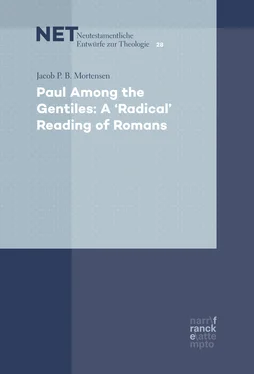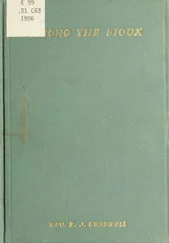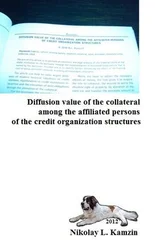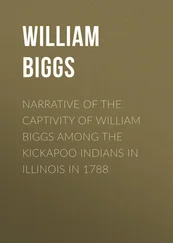1 ...7 8 9 11 12 13 ...26 Caroline Johnson Hodge has worked to determine how to understand the Gentiles in Paul, both from Paul’s own perspective, and from the Gentiles’ perspective.1 Even though Paul and the Gentiles undergo various transformations in identity in his letters, he never separates himself from Judaism, and he intentionally affiliates his Gentile assemblies with Israel, though not as full members. According to Johnson Hodge, the Gentiles are not Jews, and neither are they Christians. But neither are they Gentiles any longer, even though they somehow remain Gentiles. So they are Gentiles, but also not Gentiles. Paul calls them a number of things including ‘beloved’, ‘holy ones’, ‘faithful ones’, ‘brothers and sisters’, ‘heir’, and ‘a new creation’. But what Johnson Hodge struggles to determine is, what then have they become? What are the Gentiles-in-Christ?2
According to Johnson Hodge, the Gentile addressees of Paul’s letters are Gentiles ‘in-between’, who occupy an ‘in-between space’.3 From a historical perspective, as a group, the Gentiles affiliated with Judaism is not difficult to understand. Johnson Hodge explains that there are many examples of Gentile sympathizers with Judaism, as perceived by Jews in the Second Temple period. There is a wide variety of material (texts, inscriptions, etc.) in which Jews report that Gentile sympathizers adopted Jewish practices such as Sabbath observance, making offerings in the temple, attending synagogue services, and so on. But the Jews showed little interest in defining these Gentiles as a group, and neither did they consider the religious status of these Gentiles. According to Johnson Hodge, neither did Paul construct a stable identity for these Gentiles-in-Christ. This means that as a group, they resist classification – at least in an ancient or historical sense. The Gentiles-in-Christ hover around the borders of identities that they are not quite, and Paul’s definitions of them shift with his rhetoric. Consequently, Johnson Hodge offers a model of multiple identities4 and hybridity as an alternative to the idea that ethnic identities are monolithic and one-dimensional. Individuals and groups may embody several ethnic or other identities, situationally emphasizing one while downplaying others. And from this etic perspective, Johnson Hodge manages to describe what the Gentiles-in-Christ are, and how Paul emphasizes different aspects of their ‘situational identity’ in different situations – foregrounding some, while downplaying others, at rhetorically relevant points.
Joshua Garroway approaches the problem of the Gentiles in much the same way as Caroline Johnson Hodge. In his 2008 dissertation for Yale University, Garroway explains that he uses post-colonial theorists’ new perspectives on identity construction.1 He uses the construct of hybridity as articulated by theorists such as Homi K. Bhabha (1949–) and Mikhail Bakhtin (1895–1975) to better understand texts that describe ambiguous Jewish identities in antiquity. Garroway analyses several examples of proselytes and Idumeans, groups long thought to have inhabited the border between Jew and Gentile in the ancient world. And from this background, he turns to Paul’s ‘Christians’. The hybrid space Garroway identifies in Paul’s construction of Gentile identities concerns the observation that baptized Gentiles become Jews in the fullest sense of the word, while remaining Gentiles. The baptized Gentiles become Jews, but not really Jews. So Garroway constructs the neologism ‘Gentile-Jews’ in order to define the hybridized identity.
The intention of Garroway’s neologism is to present an alternative to a certain kind of binary thinking. He wants to challenge the idea of ‘pure’ groups; he wants to challenge the idea that cultures or categories of identity – whether religious, ethnic, national, or otherwise – are neatly bounded. There is no such thing as an essence, and the world – prior to being described – is not naturally divided into classes, cultures, or religions. In other words, there is no such thing as a real Jew or a real Gentile. There is only a discursive production of culture and identity, and language is what creates distinctions among things, just as power is what shapes the role and importance of language in any discursive production. Consequently, the neologism ‘Gentile-Jew’ is created to point out that any binary opposition between Jew and Gentile is first linguistic, but also part of a power play in which the ‘Gentile-Jews’ conceptually refuse to be either one thing or the other, but something else, which contests the terms and territories of both. By juxtaposing the terms of the dichotomy, Garroway identifies the hybrid space that defies classification.
In one of her several articles on Paul and his Gentile addressees,1 Paula Fredriksen approaches the problem of the Gentiles from the perspective of ancient Jewish apocalyptic beliefs.2 Some of the ancient apocalyptic traditions directly addressed the fate of the non-Jews at the onset of Israel’s eschatological redemption. These traditions were mixed, though. Some were adverse, some were favourable, and sometimes both adverse and favourable traditions appeared in the same text.3 However, according to Fredriksen, what mattered to Paul and the early Jesus movement were the eschatological traditions that foretold the inclusion of the Gentiles (or the nations) with a reassembled Israel ( e.g. Isa 2:2–4; 25:6; Mic 4:1ff.). In the traditions somehow informing Paul’s beliefs, this could be expressed thus: ‘In those days ten men from the nations of every tongue shall take hold of the robe of a Jew, saying ’Let us go with you, for we have heard that God is with you.”’ (Zech 8:23) Or the Gentiles themselves might be described as carrying the Jews in exile back to Jerusalem ( Ps. Sol. 7:31–41). Or the Gentiles would be described as burying their idols because ‘all people shall direct their sight to the path of uprightness’ (1 Enoch 91:14).
It may be conceptually difficult to distinguish between the inclusive eschatological traditions receiving Gentiles into the family of Israel, and the non-eschatological Jewish practice of receiving Gentiles into diaspora synagogues. But Fredriksen argues for a crucial difference: From the point of view of Jewish synagogues, the proselytes ( i.e. circumcised or converted Gentiles) were no longer Gentiles – they were Jews of a special kind (though not historical-ethnic Jews). But the synagogue’s God-fearers (or Judaizers) were still ‘active’ Gentiles (or pagans as Fredriksen prefers). From an inside, Jewish perspective, everyone who had not converted to Judaism – despite how sympathetic they might have been – was considered Gentile (or pagan). They might still worship their own native gods, even if they also worshiped the one God of Israel. The dividing line now is that when the Lord of the universe reveals himself in glory and the day of wrath arrives, as the eschatological traditions describe it, the nations (or Gentiles) will destroy their idols, repudiate their gods, and worship Israel’s God together with Israel. This means that in the eschatological texts of the Hebrew Bible, the category of an uncircumcised Gentile worshipping with Israel is a theoretical or hypothetical possibility in the last days. The Gentiles worshipping with Israel in these final days assume the position of ex-pagan pagans, or ex-pagan Gentiles. According to the apocalyptic texts, the destruction of their idols would not imply that these Gentiles converted to Judaism. The Gentiles do not convert, but they do turn (στρέφω). When, in the last days, God redeems Israel, the Gentiles (or the nations) will turn from the lesser gods – whose images they worship – and turn to the one God of Israel (cf. Isa 45:22; Tob 14:6). Fredriksen takes this to be the background of Paul’s claims to his Gentile addressees, quintessentially expressed thus: ‘You turned to God from idols, to serve the true and living god’ (ἐπεστρέψατε, 1 Thess 1:9).
Читать дальше












